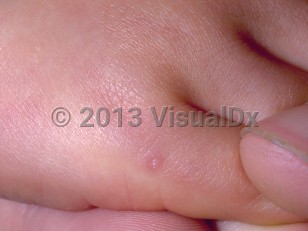Infantile myofibromatosis in Child
Alerts and Notices
Important News & Links
Synopsis

Infantile myofibromatosis is the most common fibrous tumor of infancy. The majority of cases present within the first 2 years of life (90%), and 60% present at birth. While most cases are sporadic, familial cases have been reported. Infantile myofibromatosis occurs more commonly in boys (60%). There are 3 forms of the disease: solitary (the most common), multicentric, and generalized. The multicentric form appears more often at birth and in girls.
In the solitary form, a single papule or nodule affecting the skin, subcutaneous tissue, or muscle is present, most commonly on the trunk, head, or neck. In the multicentric form, lesions can be seen in the bone and viscera. Skeletal lesions occur in more than half of cases, with the skull, femur, tibia, spine, and ribs involved most commonly. The generalized form of the disease is characterized by visceral involvement and usually has a poor prognosis. The most common sites of visceral involvement include the heart, lung, bones, and gastrointestinal (GI) tract.
Without visceral involvement, the prognosis is favorable: it is typically benign and self-limited and has a low recurrence rate.
PDGFRB germline mutations have been associated with inflammatory myofibromatosis in some cases and may predispose to the formation of cerebral aneurysms.
In the solitary form, a single papule or nodule affecting the skin, subcutaneous tissue, or muscle is present, most commonly on the trunk, head, or neck. In the multicentric form, lesions can be seen in the bone and viscera. Skeletal lesions occur in more than half of cases, with the skull, femur, tibia, spine, and ribs involved most commonly. The generalized form of the disease is characterized by visceral involvement and usually has a poor prognosis. The most common sites of visceral involvement include the heart, lung, bones, and gastrointestinal (GI) tract.
Without visceral involvement, the prognosis is favorable: it is typically benign and self-limited and has a low recurrence rate.
PDGFRB germline mutations have been associated with inflammatory myofibromatosis in some cases and may predispose to the formation of cerebral aneurysms.
Codes
ICD10CM:
Q89.8 – Other specified congenital malformations
SNOMEDCT:
254146000 – Infantile myofibromatosis
Q89.8 – Other specified congenital malformations
SNOMEDCT:
254146000 – Infantile myofibromatosis
Look For
Subscription Required
Diagnostic Pearls
Subscription Required
Differential Diagnosis & Pitfalls

To perform a comparison, select diagnoses from the classic differential
Subscription Required
Best Tests
Subscription Required
Management Pearls
Subscription Required
Therapy
Subscription Required
References
Subscription Required
Last Reviewed:07/15/2023
Last Updated:07/16/2023
Last Updated:07/16/2023
Infantile myofibromatosis in Child

